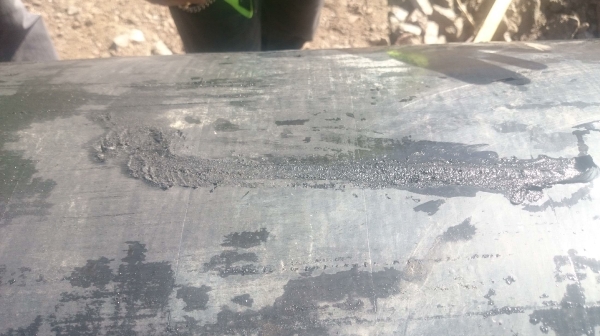HDPE coated RD piles for new hospital building in Turku, Finland
Turku University Hospital (TYKS) is building a massive new building, named T3 Hospital, on top of existing E18 freeway and a rail road. New building will have total area of 54 000 m2 in eight stories. Total budget for the project is 158 M€.
Figure 1. New building will rise on top of existing E18 freeway and a railroad, just next to T2 Hospital (photo: www.vsshp.fi).
Due to tight schedule of the project and demanding soil conditions, drilled RD piles were chosen for the project. Pile sizes RD800, RD600 and RD400 are used. RD800 piles are drilled three meters (4xD) and smaller ones 2 meters into the bedrock and grouted to the hole to ensure rigid connection. Piles are inclined and also tension anchors are used to take heavy accidental lateral and lifting loads.
Due to cold winters in Finland, a de-icing salt is often used for roads. This causes severe corrosion environment for steel piles. In TYKS T3 project RD800 piles are exposed to de-icing salt and the corrosion is taken care with 3-layer HDPE coating on piles. Additional to the coating, the resistance of the piles has been calculated with extra 2 mm corrosion allowance to wall thickness.
Handling and quality of the coating in focus
One of the most important things to ensure intact coating is careful handling of the piles at all stages of the transportation and installation. To ensure the coating is intact after installation three of the piles were lifted up after drilling. The coating of these test piles was checked visually and if necessary also with a holiday detector. “Two first test piles have shown no remarkable marks in the coating”, says Reino Heikinheimo, geotechnical designer from Ramboll Finland, and continues: “Only some small holes at the pile toe, where the clamps of the drill rig have grabbed to the pile pipe. These holes aren’t causing corrosion problems due to grouting of the pile toe to the bedrock. I think the reason, why the coating has remained intact, is very careful and skillful installation team”.
Before the start of the project Lemminkäinen, the contractor, thought coating would cause significant problems during installation. “We prepared for damages in the coating with training of repair and a big bunch of repair materials. Now we have installed 97 pcs of coated piles and we have used only handful of repair patches”, says Kai Jaakkola, drilling supervisor for Lemminkäinen. “Our installation team has learned more gentle way to handle piles. I think this helps us also in normal projects, because they are handling also un-coated piles with more care”.
Cutting and peeling of the piles
Since the coating is a plastic material, the cutting can’t be done with a cutting torch. Too high temperature would set the coating on fire. The cutting of the piles has been done with plasma cutter, which produces significantly less heat.
Due to heavy lateral loads, there is a need to get a rigid connection between concrete foundation and the pile pipe. Therefore the coating is removed from top most part of the pile. This is done with the help of little heat.
HDPE coated piles
External triple-layer coating is done according to DIN 30670 N-n (1991) standard. An epoxy film protects the pile against corrosion while a polyethylene film shields the epoxy film against damage. Third layer is an adhesion layer between epoxy and polyethylene film. Prior to coating the pile pipe is cleaned by sand blasting and the smoothness of the surface is checked.
Usual thicknesses vary from 2.2 mm (RR/RD400) to 3.0 mm (RR/RD1200). In severe conditions an increased thicknesses, +0.7 mm, are used. Maximum thickness available is 6.0 mm.
HDPE coating can be applied to SSAB’s large diameter piles (RR/RD400…RR/RD1200). The production line enables coating of 10…18 meter long pile pipes. Also longer piles are available with splice welding and a joint coating.
Storing and handling of the coated piles needs much more attention than uncoated piles. Clamps and other lifting equipment can easily leave marks to the coating. Wooden backings are required when pile pipes are stored at the site, and extra care needs to be paid to pebbles and stones. All sharp edges and jigs need to be removed from drilling rig.
If in spite of above the coating has damaged, it can be repaired. Damaged polyethylene can be repaired with special repair materials. When damaged area is small, also epoxy can be fixed. In larger damaged areas the damaged part needs to be removed.
Figure 2. RD800 piles are drilled and waiting for cutting. Inclination is due to heavy accidental loads.
Figure 3. Some of the piles were drilled from closed freeway lanes during night time.
Figure 4. Ready RD800 piles (cut, peeled, reinforced and concreted).
Figure 5. Small marks at the coating of extracted test pile number two (photo: Arto Heikkilä Ramboll CM Oy)
Attachments
Category and tags




